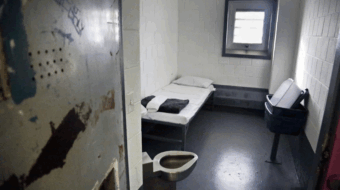ATLANTA, Georgia, 5 Feb (IPS) – Homeless advocates in the United States say if the new Congress and the Barack Obama administration do nothing, many more low-income people already teetering on the brink could end up living on the streets over the next two years.
‘The numbers, unfortunately, are expected to rise and get worse before it gets better,’ Michael Stoops, executive director of the National Coalition for the Homeless, told IPS. ‘It’s going to get worse unless people come to the bargaining table.’
‘We’ve projected there [will] be an additional 1.5 million people who experience homelessness over the next two years if we don’t do anything,’ said Nan Roman, president of the National Alliance to End Homelessness (NAEH).
The NAEH broke down statistics that show homelessness decreased from January 2005 to January 2007, based on snapshot counts collected by homeless services agencies that are required by the government to count their client populations every other year on one night in January.
The count fell from 744,313 in 2005 to 671,859 in 2007. Overall, 34 states and the District of Columbia reported decreases in homelessness.
But more recent figures signal a reversal of this trend. In December 2008, the U.S. Conference of Mayors found that of 25 cities surveyed, 19 reported some kind of increase in homelessness between Oct. 1, 2007 and Oct. 30, 2008.
The report concluded that it is ‘unclear’ how the economic crisis and foreclosure epidemic will affect homelessness in the next two years. ‘However, with the economy in a recession and unemployment rising, it is likely that the need for homeless services will remain steady if not increase,’ it said.
Foreclosures are pushing many people into the streets who were already close.
The National Low Income Housing Coalition (NLIHC) reported in December 2008 that more than a fifth of the properties facing foreclosure nationwide are rentals and because rental properties often are home to multiple families, renters make up nearly half of the families facing eviction.
As a result, very low-income families and low-income and minority communities bear the brunt of rental foreclosures.
‘The way the economy is with foreclosures, people are in unstable housing situations,’ said Danilo Pelletiere, research director with the NLIHC. ‘They will end up on a neighbour’s couch or something. As they run out of options…they are going to end up on the street.’
‘There is this lag period [between] when the jobs dry up and when people become homeless,’ he added.
Twelve of the 25 survey cities in the Conference of Mayors report blamed the increase in homelessness on foreclosures. Additionally, 60 percent of cities said a lack of affordable housing caused homelessness while 72 percent said the shortage caused homelessness for families.
‘You look at people who have already lost their homes – where are they?’ Stoops asked. ‘They move in with family and friends. They will move in to their RV and park it in a state campground. In reality, whether you are rich or working class, no one is immune from becoming homeless.’
When asked if their cities had adopted policies aimed at preventing homelessness among households that had been living in foreclosed homes, only 13 cities – barely half – replied that they had.
‘Many Americans are now losing or facing the prospect of losing their homes as both homeowners and renters feel the impact of the foreclosure crisis, and millions more Americans are likely to fall into deep poverty in the coming months as a result of rising unemployment and declining state and local funding for safety net programmes that assist people who are unable to find work,’ said Deborah DeSantis, president of the Corporation for Supportive Housing.
‘Among them will be thousands of vulnerable and disabled people who will need supportive housing,’ she added. ‘Congress and the new president need to commit even more federal help to our efforts to combat homelessness in every community.’
To target chronic homelessness, groups like NAEH have encouraged cities to enact long-term policies to end homelessness, often referred to as ’10-year plans to end homelessness.’
The Conference of Mayors reported that 24 of 25 cities surveyed had developed a 10-year plan to end homelessness and many of these focus not just on ending homelessness for chronically homeless disabled adults but also on preventing family homelessness.
Still, 16 cities reported an increase in family homelessness while only six reported a decrease or no change.
‘The presence of a 10-year plan is not a guarantee that anything is going to happen,’ Roman said. ‘You have to implement the key strategies. You have to do prevention. You have to move people faster out the back door through rapid rehousing. It’s [really] whether you’re changing your system and making the investment.’
‘There’s nothing wrong with a plan or 10-year goal,’ Stoops said. ‘[But] unless there is additional commitments from the public and private sectors, the plan is meaningless. There will be some cities that come to the end of their 10 years and there will still be homelessness.’
The NAEH recommends Congress and the Obama administration create 400,000 new housing vouchers, invest 2 billion dollars in homeless prevention and rapid rehousing, and invest 10 billion dollars in the National Housing Trust Fund.
The NLIHC believes a similar investment in the Trust Fund will allow the nation to rehabilitate or build 100,000 rental homes for the lowest income households using green standards over the next two years.
‘We believe that those three things together would be enough to really stop an additional 1.5 million from becoming homeless,’ Roman said. ‘Longer term, we need a solution to the affordable housing problem. People feel like there is so much housing and there is so many foreclosures but [housing is] still not affordable [for poor people].’
To create more affordable housing, the NLIHC recommends investing 5 billion dollars in public housing capital funds and 3 billion dollars for the preservation of urban and rural federally assisted housing.
‘There certainly is not enough money for public housing,’ Pelletiere said. ‘There’s this real underinvestment.’
The group also recommends 2 billion dollars for relocation and temporary housing assistance for tenants who are evicted from homes that are foreclosed upon.
‘We’ve been pushing very hard to get extra funding for those federal programmes,’ Pelletiere said. ‘The moment someone is destabilised in their home and turned out… if we can avoid that or give sufficient notice, that’s going to lessen the damage significantly.’










